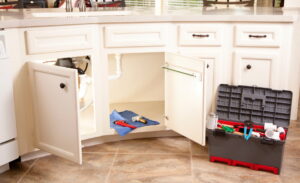No one wants to deal with a plumbing emergency that causes flooding in your home, but unfortunately, we see it frequently enough. When you plan ahead and are prepared for a plumbing emergency in advance, the situation is a lot easier to manage in the moment.
Of course, when a plumbing emergency strikes, you can give our team a call for an emergency plumber in Loganville. We can be there quickly and help you no matter what your plumbing emergency is. In the meantime, you can keep reading to learn more about some of the concerns you face with flooding during a plumbing emergency and how to be prepared. For additional tips, read our guide on how to prepare for an emergency plumbing situation.
Risks of Flooding
If your home floods because of a plumbing emergency, you face a variety of problems. First, you have to deal with the plumbing damage itself. Then you’re left with water damage to your home because of flooding. Even if you are able to turn off the water and clean up the mess quickly, the damage may already be done. Water can soak into hard floors, carpeted areas, cabinets, and even sheetrock.
One reason you want to clean up water as soon as possible is to reduce the risks of mold developing. The longer that water stands and surfaces in your home are wet, the more likely it is that mold will begin to spread. We’re highlighting some tips below to help you mitigate these risks and be prepared in case you ever face a plumbing emergency with flooding.
Locate the Emergency Shut Off Valve
The first step to being prepared for a plumbing emergency and the potential of flooding is to locate the emergency shut-off valve for your water service. Sometimes the only way to stop flooding when something goes wrong with your plumbing is to turn off the water to your home completely.
Otherwise, a busted pipe or other plumbing issue will continue flooding your home without ceasing. By locating the valve now, you’ll be prepared if something ever does happen. You won’t have to waste precious minutes trying to find the shut-off valve during a plumbing emergency.
Be Ready for Clean Up
Sure, you have to wait for a service appointment with our team to fix the plumbing problem. But in the meantime, you can do your best to clean up the area and get up as much water as you can to reduce the long-term impact. Use towels or a mop to soak up water, or rent a shop vac from a local hardware store to vacuum up the water a little faster.
Once you get the water cleaned up, you also need to use cleaners. Wiping down surfaces with disinfectants will help to reduce the likelihood of mold growth. Of course, you also have to consider that water can seep into porous materials like cabinets, floors, and sheetrock. You may have to invest in professional treatment. For more advice, see our post on when a plumbing problem becomes a plumbing emergency.
If you don’t already have one, you might consider installing a whole-house indoor air purifier to help reduce the number of mold spores in the air and prevent a mold infestation. The benefit of an indoor air purifier is that you’re also eliminating a lot of other harmful particles, like allergens, bad odors, and bacteria from the air. Additionally, if your plumbing system is older, you may want to consider whole-house repiping to avoid future emergencies.
Your Comfort Is OUR Business. Contact the team at Snellville Heating today to schedule an appointment for the highest quality HVAC services.





